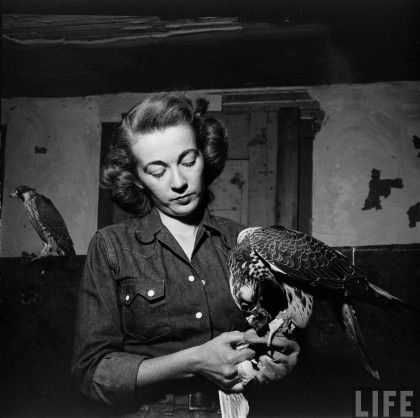
I recently came across a 1952 LIFE magazine article profiling a group of falcon banders working on Assateague Island, Maryland. Along with the article is a series of striking photos of the banders and their lifestyle on the coast.
Their strange capture technique required one person to be buried up to his neck in sand, with a crate over his head for concealment. The buried person held on to a string that tethered a pigeon “lure” bird. Once a falcon attacked the pigeon, the string would be pulled close enough for the buried trapper to reach out and grab the falcon’s legs.
Face to face with a falcon, Brian McDonald heaves out of the sand.
The thrill of victory!
Halter Cunningham holds a hooded falcon.
Coffee with falcons.
These days there are less intimate ways of catching hawks and falcons, but the tradition of trapping them on the east coast in fall during migration continues on in such places as Cape May, NJ and Kiptopeke, VA. Both of the trappers featured in this LIFE article went on to make important contributions to raptor conservation ( Halter Cunningham and Brian McDonald). They witnessed the worst of times, as the falcons they were banding in 1952 were part of a dwindling population that succumbed to the ravages of DDT pollution.
Ten years after this article appeared in LIFE magazine, Silent Spring was published. This book brought attention to the environmental crisis DDT was causing. Today’s banders are catching falcons that are part of thriving populations restored by the efforts of many individuals and organizations over the decades since DDT was banned.
Here is a link to dozens more photos from this article on google images and here is the original LIFE article.